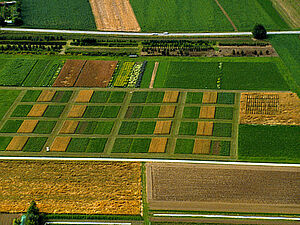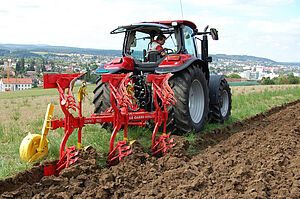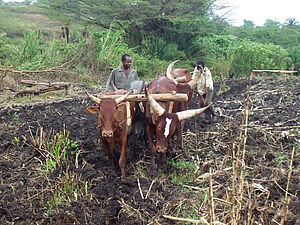The combination of traditional knowledge with modern ecosystem research outcomes has resulted in strategies allowing for improved soil fertility and productivity. The focus in this respect is on humus formation and on the enhancement of soil biological activity, resulting in the stabilisation of the soil structure and increased water retention in the root zone. This in turn reduces the soil’s susceptibility to erosion. Sustainable technologies such as reduced tillage, intercropping, the integration of legumes into crop rotations as well as the use of organic fertilisers are at the forefront of endeavours to achieve these aims. Moreover, the breeding of stress-tolerant crop cultivars is playing an increasingly important role.
Organic farming combines a range of sustainable practices into an overall system. In most cases this also entails the combination of tillage farming with livestock farming, with attendant benefits for both soils and the climate. Long-term trials conducted by FiBL have yielded important answers to questions relating to soil conservation and food security which are also, in turn, linked closely to the climate. A selection of these projects is outlined below.
A unique long-term trial
For the past 37 years, FiBL (Frick) and Agroscope (Reckenholz) have been comparing agricultural production systems in a long-term field trial at Therwil (Basel District). This trial has shown that organic farming clearly enhances a range of soil fertility indicators such as earthworms, micro-organisms, and in particular symbiotic mycorrhizal fungi. Moreover, soils receiving farm manures as opposed to mineral fertilisers sequester an additional 0.5 to 1 ton of the greenhouse gas carbon dioxide per hectare and year. Organic systems are also more energy-efficient: Per unit of yield they require 20 percent less energy input. Their climate impact (in terms of emissions of CO2 equivalents) is similarly favourable. In addition, it has been shown that organic farming contributes to the maintenance of above-ground and below-ground biodiversity.
This DOK-Trial is unique in the world. Soil and plant samples serve as reference material for numerous international projects. The trial has also served as a template for a range of systems comparisons in the tropics run by FiBL in cooperation with local partners, for example in Kenya, Central India and Bolivia.
Higher yields thanks to reduced tillage
Numerous studies have verified the benefits for soil fertility of reduced tillage systems. However, in non-organic farming such tillage systems necessitate herbicide usage. Over recent years FiBL’s Department of Soil Sciences has developed reduced tillage systems for the organic context. A 13-year field trial at Frick has shown that reduced tillage under organic conditions results in the sequestration of 3.7 tons of CO2 per hectare and year in the topsoil layer. Moreover, due to improved drought tolerance average yields are somewhat higher than those in ploughed trial variants. Plots under reduced tillage have significantly higher yields in drought years. The inclusion of a legume-based green manure crop which fixes aerial nitrogen with the aid of rhizobia increases maize crops by as much as 34 percent. Under reduced tillage, conditions also improve for symbiotic fungi and earthworms which “return the favour” by contributing to improved soil structure and greater proportions of plant available water. This example very clearly attests to the fact that improved soil fertility can also contribute to increases in organic yields. In this context, both modern technology and an understanding of biological processes in the soil-plant system are key.
New projects in the Year of Soils
The FertilCrop project commenced in early 2015. FertilCrop is a three-year research project aimed at developing improved cropping methods, new techniques and decision-making aids for the organic farming sector. To this end, researchers and farmers, soil physicists and specialists in weed control, plant nutrition and climate change have come together to work on this project. In their joint experiments and field trials the project staff focus on interrelationships between, for example, weed growth and tillage crop yields or between soil profile and structure and the soil life it hosts. A total of 20 research partners in 13 European countries are participating in field trials from which data will be collated and evaluated. The results are to contribute to the development of environmentally sound and locally adapted tillage cropping systems while also increasing organic yields.
The BetterGardens project is being undertaken in urban parks and gardens. The project’s objective is to develop strategies for the optimum management of urban greenspaces. To this end, the researchers are investigating how people establish their gardens and what factors influence the decisions they take in this context. In the cities of Berne, Zurich and Lausanne project staff are taking a close look at private allotments, green oases on rooftop terraces, and community gardens. They are also investigating the impacts of a range of production strategies on biodiversity and soil quality.
In the ECOSERV project, a European research team is investigating the impact of extreme precipitation conditions on the soil nitrogen budget in different ecosystems. As part of this project, FiBL focuses on the question as to whether soils under long-term organic management are more robust than those under conventional management. The generation of nitrogen for plant uptake as well as leaching and gaseous losses (nitrous oxide, ammonia) are of major interest in this context.
Another European project, involving 26 partners, commenced recently. The iSQAPER project aims at developing suitable soil quality indicators for different land-use systems. In addition, the researchers endeavour to use suitable agricultural practices in order to improve polluted soils in selected regions, working closely together with farmers. FiBL’s involvement in this project heavily draws on the institute’s long-term trials. FiBL also works on molecular biological methods for the functional characterisation of soil microorganism communities and on new soil testing systems for assessing “soil fatigue”. There are a range of causes of this “fatigue” and its resultant yield depressions (pollutants as well as weeds or fungi) which can be identified using a range of different measures and a process of elimination.
Especially in developing countries, farmers are increasingly having to deal with issues related to soils and soil fertility. Humus loss is a problem and solutions to this problem are needed in order to ensure food security. As part of the ORM4Soil project, project staff in cooperation with farmers in the African countries of Mali, Ghana, Kenya and Zambia are researching new approaches to improving soil fertility. The exchange between scientists and producers allows farmers to gain greater awareness of the issues and they learn how to improve and protect their soils.
Global change in general and climate change in particular count among the greatest challenges faced by farmers and food producers. These pressures are compounded by mounting resource scarcity and growing populations in particularly vulnerable regions, putting agricultural productivity and food security at risk there. FiBL’s scientists together with an international team of experts are now working to identify agricultural practices and cultivation systems that are both resource-efficient and well suited to smallholder production in drylands. There is a substantial body of knowledge about this and diverse hypotheses – all of which, however, has never been compiled systematically and studied comprehensively with a scientific approach. The project titled “Potential of Sustainable Land-Use Systems to Promote Adaptation to Climate Change”, funded by the Mercator Foundation Switzerland, is seeking to close that gap.






